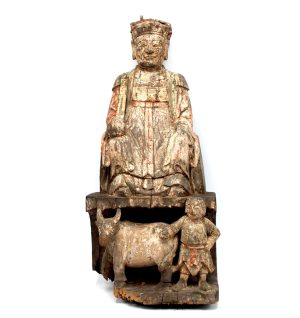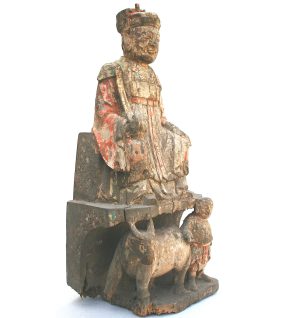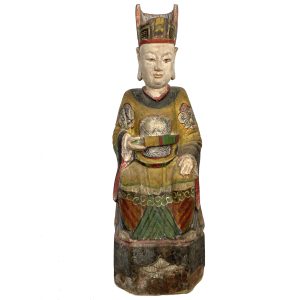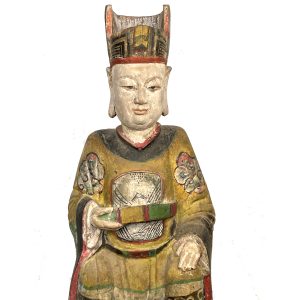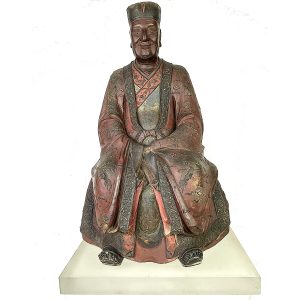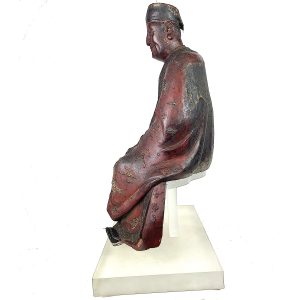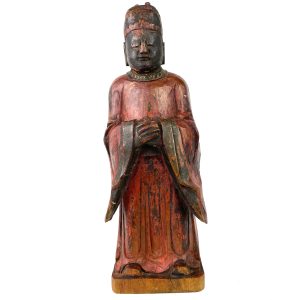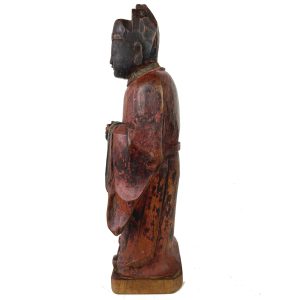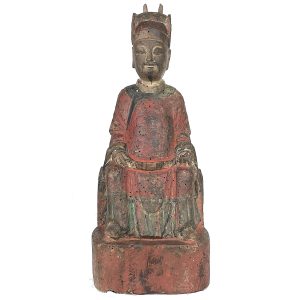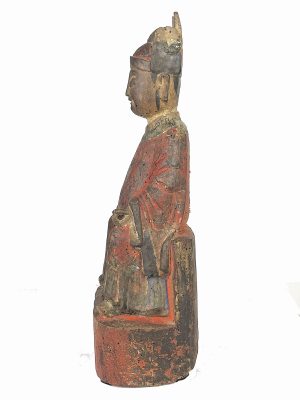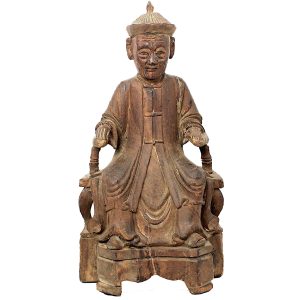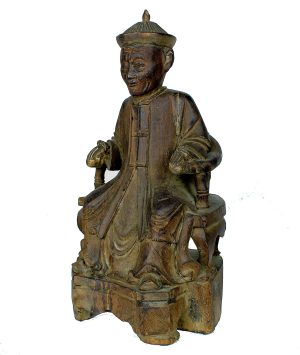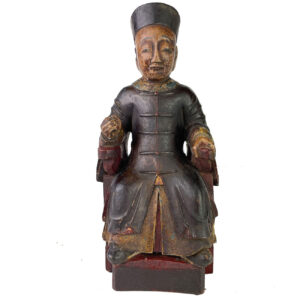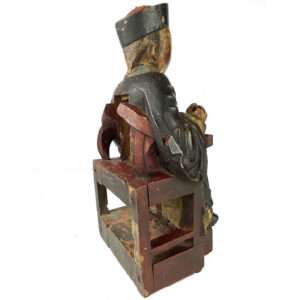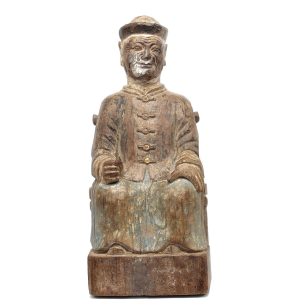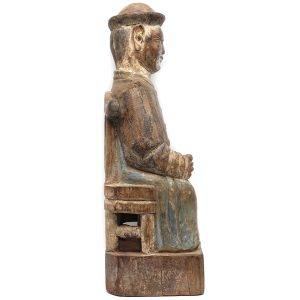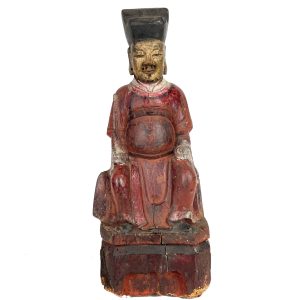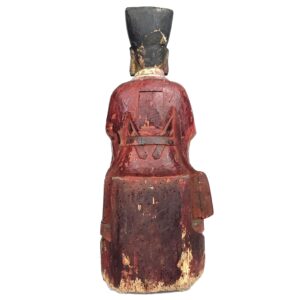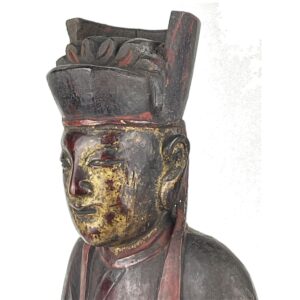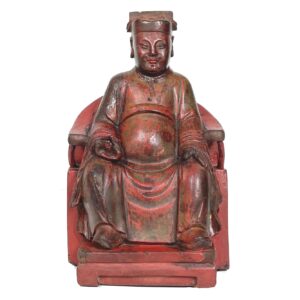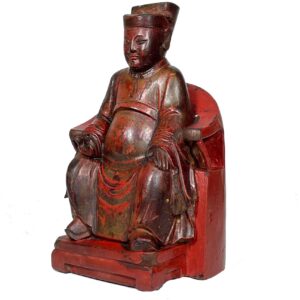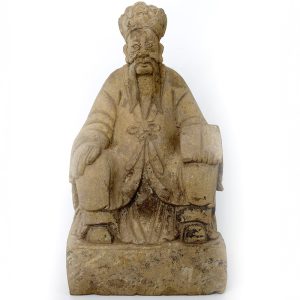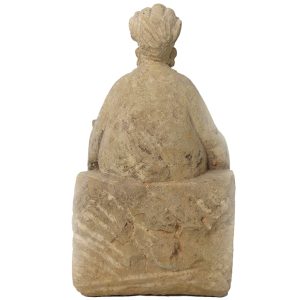Showing 1–12 of 14 results
-


$885.00
This extremely rare late Ming/early Qing dynasty carving is divided in two parts and is significant for its juxtaposition of images as well as its unique iconography. The top is one of the Taoist officials in typical officialsattire: an official’s hat, a tiered robe with a red sash extending to the tops of the shoes….
-
Sale!


$2,385.00 Original price was: $2,385.00.$1,900.00Current price is: $1,900.00.
H: 34″ W: 11.25″ D: 7.25″ | CALL 213-568-3030 OR EMAIL [email protected] FOR SHIPPING
Although this ancestor is depicted as an official, his atypically benevolent face makes him a very endearing figure. Due to South China’s climate and modernization, it repainted in the 20th century, common in weathered carvings.
-
Sale!


$4,950.00 Original price was: $4,950.00.$4,200.00Current price is: $4,200.00.
H: 23.5″ W: 15.625″ D: 10″
CALL 213-568-3030 OR EMAIL [email protected] for shipping.
This exceptional official is one of the most significant ancestor figures in our collection. His attire, glass eyes and distinct facial features indicate a wise man of importance who commands respect. Cranes and clouds symbolize longevity, wisdom, good fortune and emphasize his high rank.
-
Sale!


$425.00 Original price was: $425.00.$250.00Current price is: $250.00.
Ht: 8.25″ W: 3″ D: 2.125″ | FREE SHIPPING IN CONTINENTAL US
Ancestor figure portrayed as a civilian official standing on a rectangular base with hands together wearing a long civil official’s robe that extends to his shoes.
-
Sale!


$395.00 Original price was: $395.00.$275.00Current price is: $275.00.
H: 13.75″ W: 5.25″ D: 4″ | FREE SHIPPING WITHIN CONTINENTAL U.S.!
This ancestor figure, carved in boxwood the preferred wood softwood during the Qing Dynasty, is portrayed in the characteristic pose of a Chinese civilian official, grasping his official’s belt with his right hand to demonstrate his important stature – which was really not so important for this gentleman, given his humble seating furniture and his modest attire. His right hand rests on the his knee as he sits erect on a thick low-back pedestal. Unlike many officials who are serious, this one is more approachable, with simple deeply carved smiling features, high arching brows and a black painted mustache and beard.
-
Sale!


$850.00 Original price was: $850.00.$695.00Current price is: $695.00.
H: 12.75” W: 6.625” D: 5.75” | FREE SHIPPING within Continental u.s.
This masterfully carved ancestor as a mandarin official sits on horseshoe chair set on a footed high decorated plinth dressed in a well-appointed formal 3-button Mandarin long coat and pointed rattan hat. His face is uniquely and unusually individualized with heavy lidded eyes, in a benevolent expression and his advanced aged indicated by the wrinkles clearly depicting a loved individual. This exquisitely carved image in excellent condition with a fine patina was true homage to a revered family member and is one of our finest ancestor figures.
-
Sale!


$455.00 Original price was: $455.00.$295.00Current price is: $295.00.
H:8.5 ” W: 4 ” D: 3.3 ” | FREE SHIPPING WITHIN CONTINENTAL U.S.!
Portrayed as an official, this ancestor figure sits on a horseshoe chair showing his status wearing compulsory officials attire: a 5-button Mandarin long coat with a round collar and official headwear – a woven hat whose shape and color reflected his rank. His personalized personalized oval-shaped is tranquil with a hint of a smile on his pursed lips, and a triangular pigtail down his back.
-


$595.00
During the Qing Dynasty, reverence for Mandarin officials and their associated high status with it was so significant that families sought to perpetuate this image through the generations in carved and painted renderings of their ancestors. Ancestor-figures were the highest form of filial piety, and ancestor-worship was a cornerstone of Confucianism. Stuart (p. 82) states…
-
Sale!


$875.00 Original price was: $875.00.$475.00Current price is: $475.00.
H: 15.5″ W: 6.125 ” 4.125 D: ” | FREE SHIPPING WITHIN CONTINENTAL U.S.!
This carved ancestor figure portrayed as an official sits on a backless chair with a decorative pedestal in official’s attire: a high collared red robe, double belt above and below his ample stomach and holding a long slender curved hu-tablet, all signs of his office and status. He is vibrantly painted in red, the color of fu, as a wish for prosperity and status.
-


$985.00
H: 15″ W: 6.5″ D: 5.5″ | EMAIL [email protected] OR CALL 213-568-3030 FOR SHIPPING COST
This excellently carved civilian official with gilt highlights was commissioned by a family to place on a home altar for veneration and to impress those who viewed it. The imposing ancestor figure grasps his belt of office to show his pride in passing examinations to become a civil official, which leads to a life of rank and prosperity for him and his family. Statues like this are an affirmation of persistence, success, status and power and they honor those who display these characteristics.
-
Sale!


$650.00 Original price was: $650.00.$325.00Current price is: $325.00.
H: 7.25” W: 4.625” D: 3.5” | FREE SHIPPING WITHIN CONTINENTAL U.S.
Finely carved ancestor displaying status symbols: official’s attire and hat, horseshoe chair with feet on pedestal Masterfully carved and lacquered and is painted on front and back in red with traces of gilt – all propitious colors of “fu” as a wish for wealth, health, good fortune, long life and long life – that has faded over it years of use into a great patina.
-
Sale!


$725.00 Original price was: $725.00.$675.00Current price is: $675.00.
H: 8” W: 5” D4” | FREE SHIPPING within continental us
Wonderfully aged and weathered stone Tudi Gong reflecting many traits of this beloved Earth God holding a tael for wealth and fortune. He sat happily on an outdoor shrine, and would be happy to sit in a garden to bring an aura of past times to a new family.
End of content
End of content

